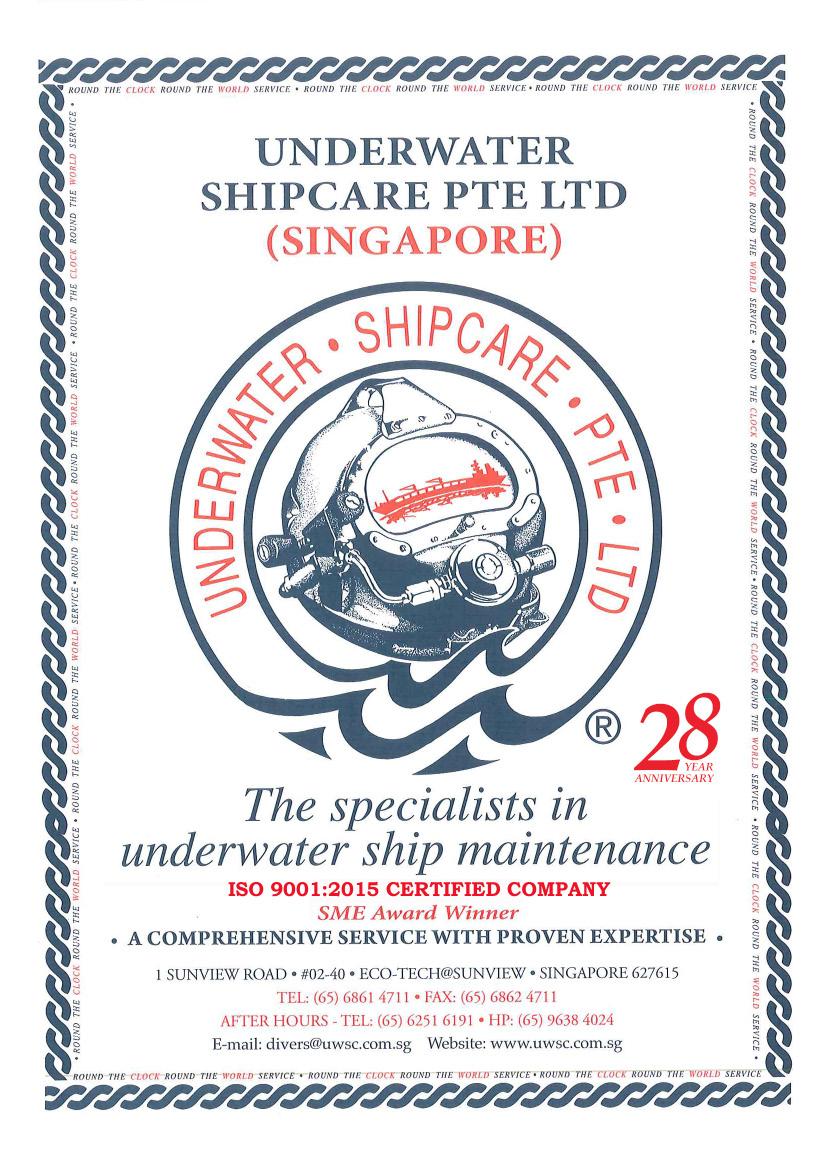
13 minute read
Underwater Repairs
Team work at Hydrex
Earlier this summer diver/technician teams from Belgium’s Hydrex’s carried out several repairs during one operation on a 165 m tanker. Work on the rudder, bilge keels and bow thruster grids was performed simultaneously during the ship’s stop in Flushing, the Netherlands.
Advertisement
By combining these repairs into one operation Hydrex brought the needed time frame down to the absolute minimum. This allowed the owner to sail his vessel on schedule to the next stop. It is a good example of the flexibility of services offered to customers. Hydrex adapts its work to owners’ schedules and can easily adjust to changing circumstances.
Hydrex split up a repair in several stages that can be carried out in the same port during consequent visits or in different ports. This might be needed if a repair is too complex to perform during one stop or if a ship only has a very short window, as is the case with cruise ships or ferries that only make a short stopover in each port.
The divers are trained to be flexible and to adjust to the specific circumstances of an operation. Hydrex’s workboats are ready for immediate deployment throughout ports in Belgium and the Netherlands. This allowed Hydrex to mobilise very quickly to the ship’s location in Flushing.
Upon arrival the men were split up into two teams. One team performed an underwater inspection of the bow thruster while the other technicians started working on the rudder. A previous inspection had revealed cracks on the rudder’s lower pintle area. The vessel could be trimmed enough to bring the damaged area of the rudder above water. This allowed the team to access the cracks using a pontoon.
The team worked on both sides of the rudder at the same time, following the same procedure. First they used a dye penetrant test to discover the crack ends. Crack arrests were then drilled to prevent further spreading. Diver/technicians ground out the cracks over their entire length. Next they were filled with Hydrex’s class approved full penetration welding. To finalise the repair the corners of the lower pintle were reshaped with a larger radius, as was advised by the attending class.
Meanwhile two thruster grid bolts were found missing during the inspection of the thruster tunnel. A total of 10 other bolts had come loose – the diver/technicians reinstalled the missing bolts and secured the other ones.
After reinstalling the bolts, this team started the last part of the operation. The bilge keels on both port and starboard side of the ship had suffered several cracks. A total of nine sections needed to be cropped or removed underwater by our diver/technicians.
On the starboard side three sections were cropped over a length of 2,600 mm while one section was removed completely. On the port side four sections needed to be cropped over
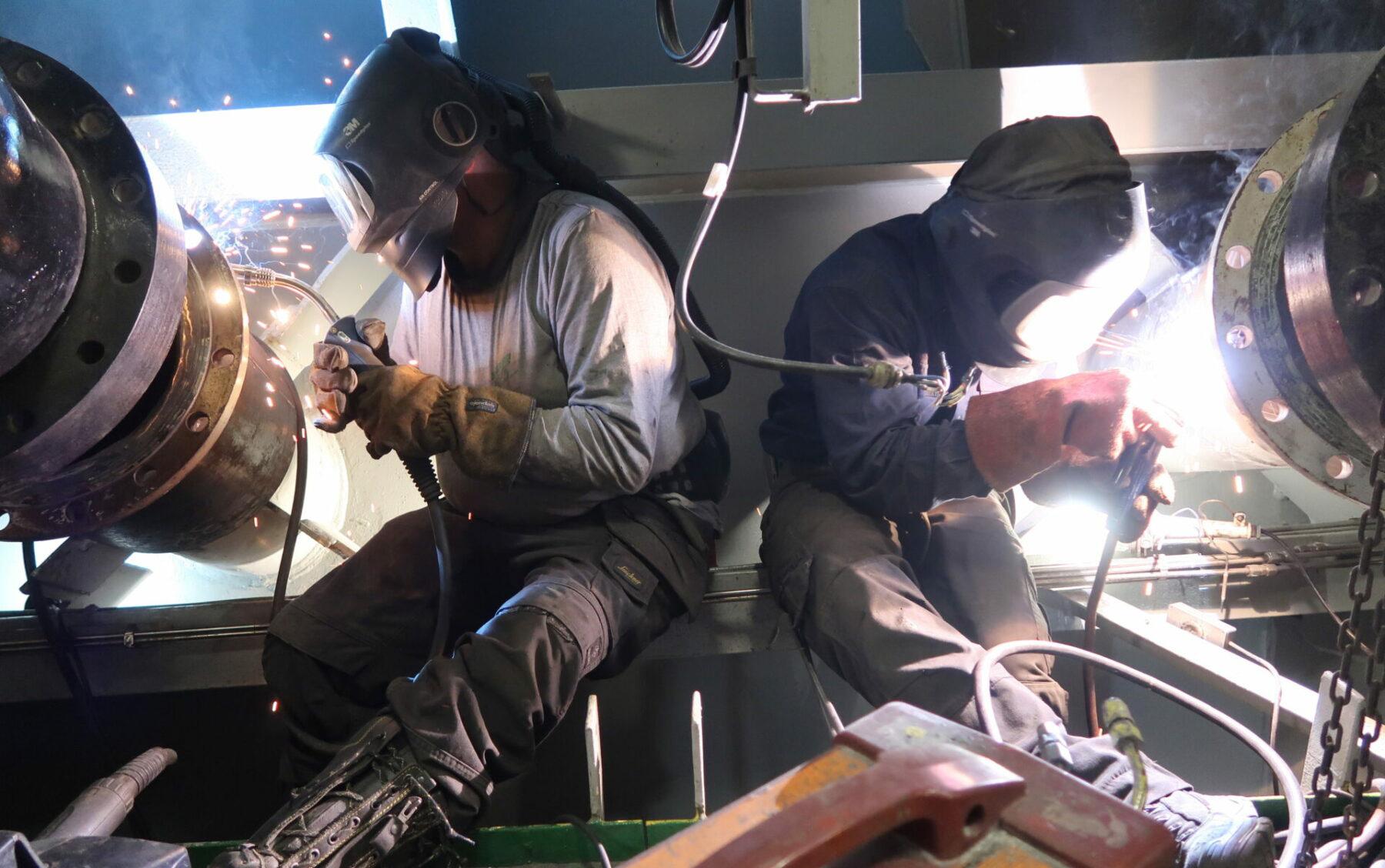
Hydrex technicians working on both sides of the rudder at the same time
a length between 2,100 mm and 2,600 mm. One section was removed completely.
Like all projects undertaken, Hydrex took on, organised and executed the entire job, start to finish. Throughout the operation Hydrex was in close communication with the customer, the classification society and any other party involved.
Diver/technicians split up in two teams working simultaneously to shorten the time frame needed for the repair. This was done to make sure that any loss of time was brought down to the absolute minimum. The owner could continue his vessel on its schedule without a costly and time-consuming trip to drydock.
Hydrex was also recently asked to assist with the three corroded scrubber overboard pipes of a 292 m bulker. The ship was not allowed to sail to drydock without a repair. Hydrex immediately sent a team to the bulker’s location in Ijmuiden, the Netherlands for a temporary solution.
Exhaust scrubbers are systems that filter out all harmful toxins from exhaust gasses of marine diesel engines. These can severely corrode the pipes of the scrubber which can result in water ingress if not handled quickly enough. For this reason the classification society requires regular thickness measurements to be performed.
The latest inspection had revealed that the three pipes were heavily corroded and needed to be repaired. The ship was sailing to drydock where the pipes would be replaced, so a fast temporary solution was required. A team travelled to the bulker’s location in Ijmuiden. After arriving at the ship they first performed an inspection of the damaged areas on both the waterside and the on-board side of the hull.
Hydrex’s diver/welders then sealed off the outlets of the overboard pipes with custom cofferdams designed and constructed at the Hydrex workshop. This allowed for work inside the engine room without water ingress. The team ground away the affected area before rebuilding it back to its original thickness. To give extra protection during the trip to drydock the team installed reinforcement shells around the pipes. When the welding was complete the surface was cleaned and an MPI was carried out by an independent inspector.
The inside of the pipes was then coated with Ecospeed to keep them safe from further corrosion. This product is produced by Hydrex sister company Subsea Industries and is highly chemically resistant. Ecospeed will also be used to coat the replacement pipes before they are installed in drydock. This will make sure that the owner will not have to call Hydrex again for the same problem.
In this case, a drydock visit had already been planned and a temporary repair was needed, but Hydrex teams can also replace a corroded exhaust pipe. This is a permanent repair that can be done while the vessel stays afloat. If a pipe is already starting to corrode a leak is just a matter of time. The owner does not have to wait until it is fully corroded, Hydrex can also replace pipes pre-emptively. By performing the replacement before the leak occurs, Hydrex’s divers prevent a costly unscheduled repair later.
Also recently, Hydrex mobilised a diver/ technician team to a 188 m car carrier in Port Burnie, Tasmania. The ship was leaking oil, making an on-site repair necessary. Using a Hydrex flexible mobdock the team was able to carry out these operations on-site and underwater, saving the owners an expensive and time-consuming trip to drydock.
Despite the remote location of the vessel, the company’s technical department was able to make all practical logistic arrangements and organise a mobilisation of the equipment very swiftly. In the recent past Hydrex has carried out several operations in Australia, including repairs on this ship’s sistership. After arriving on-site, the diving team first set up a monitoring station next to the vessel. The operation then started with a thorough underwater inspection of the stern tube seal assembly.
Next the divers cleaned the assembly and installed the flexible mobdock, thereby creating a dry underwater environment so that they could work in drydock-like conditions. The split ring was then disconnected and brought to the surface to be cleaned. After cleaning the entire assembly, the divers removed the first seal and replaced it with a new one which was then bonded. This was done in co-operation with the supervising OEM technician. The procedure was repeated with the other three seals. A successful operation was concluded with leakage tests, the removal of the flexible mobdock and the reinstallation of the rope guard.
With Hydrex organising everything from start to finish, the owner did not have to worry about making any arrangements for the repair. After the seals had been successfully replaced he was able to sail his vessel to its next stop free of oil leaks.
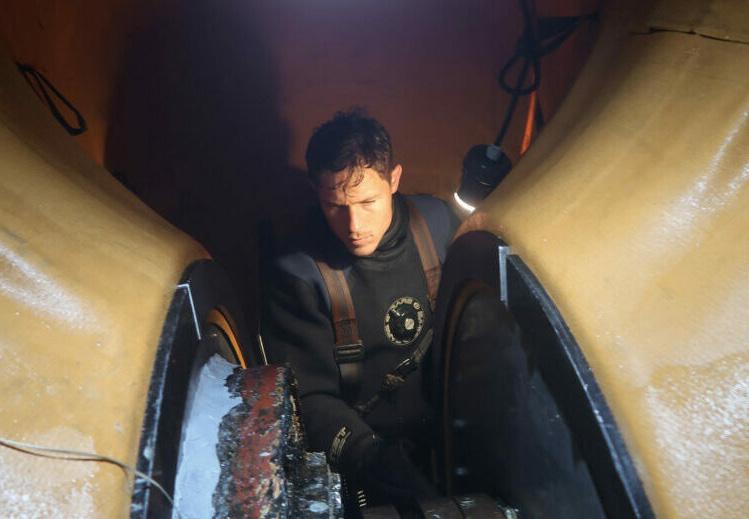
A Hydrex diver working in a mobdock
BV completes first inwater survey
France’s Bureau Veritas (BV), TIC, and service provider MaDfly (Marine Drone Services) – have successfully completed the first full in-water ship’s hull survey with a mini ROV on Brittany Ferries’ 24,534 gt ro/pax ferry Bretagne .
The survey, which was supervised by BV on behalf of the French Flag, provided an opportunity to validate the integrity of the entire ship’s hull’s bottom. Efficient underwater inspections of shipping vessels are playing an increasingly important role for the industry as a
substitute for docking surveys at agreed intervals or occasional surveys of hull damage.
This inspection was the first of its kind, with the test survey performed twice. A remotely operated drone performed an in-water survey with a BV surveyor on-board the vessel. In parallel, BV also tested the capability with its own remote inspection solutions using full HD live video footage from MaDfly. This enabled BV to carry out the survey remotely without any attended surveyor on-board with live streaming, as well as video and audio recording and photo options.
BV has noted the following benefits of using this system: • Safer operations as divers do not have to be in the water • Reduction in preparation time - with a single operator and limited equipment • High-quality pictures from the drones • Reduced risk of disturbance to ship operations
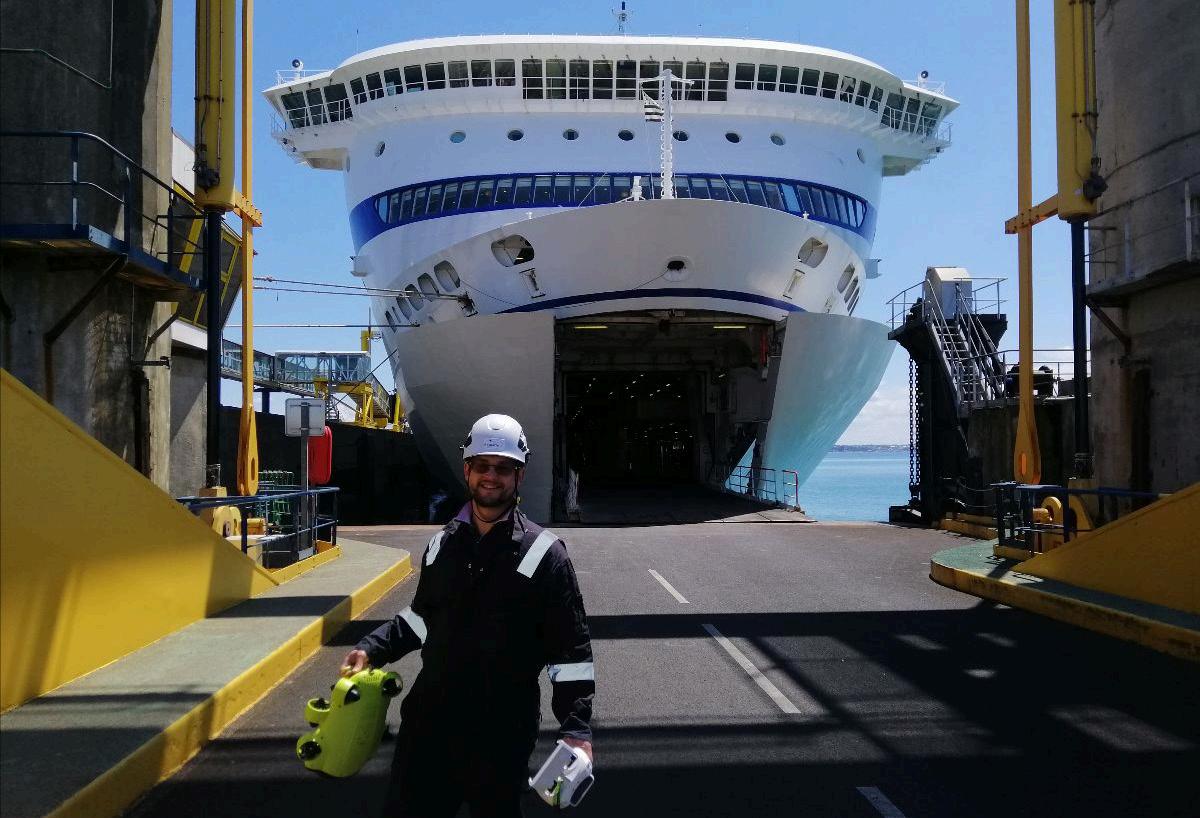
MaDfly CEO, Thierry Guillot, commented, “MaDfly’s team is delighted to be the first company in the world to achieve a vessel survey with a mini ROV for BV - even more for a Brittany Ferries’ vessel, as this company supported us from the very first day. New technologies are improving daily to achieve more and more maintenance services in a safer
The first full in-water ship’s hull survey with a mini ROV on Brittany Ferries’ ship Bretagne
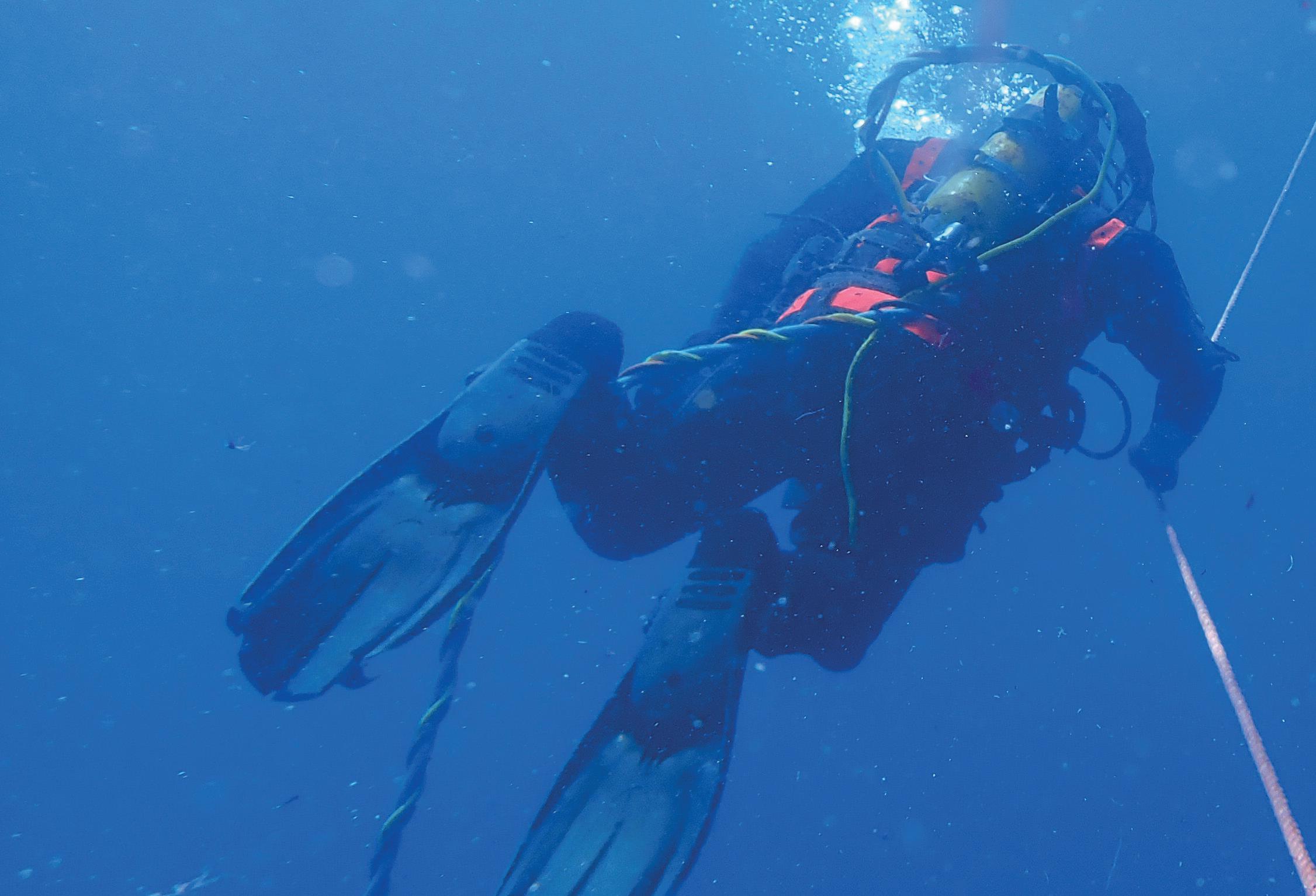
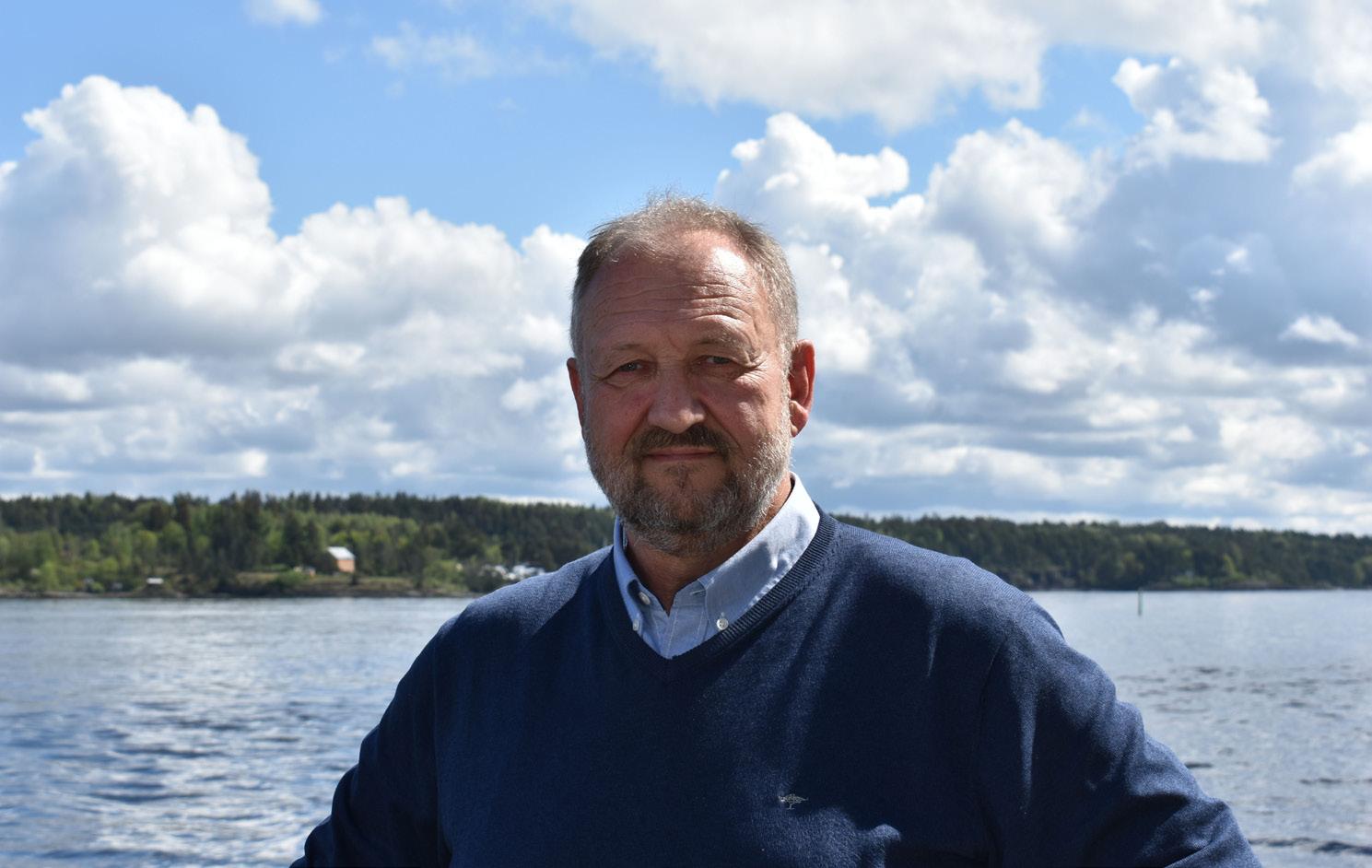
John Gunnar Refsnes
and more cost-effective way.”
Arnaud Le Poulichet, Technical Director for Brittany Ferries, added, “Brittany Ferries has always invested in research and development and this partnership is a success. This underwater inspection with a mini ROV demonstrated the technical relevance of this method and reduced the inspection time.”
Laurent Leblanc, Senior Vice President Technical & Operations for BV Marine & Offshore, said, “Underwater remote surveys improve safety and reduce risk, time and costs to produce high-quality results. Maintaining the integrity and safety of a ship is a crucial task. Today, technology brings digital classification to another level, providing new opportunities and options to our clients.”
New man at Miko Marine
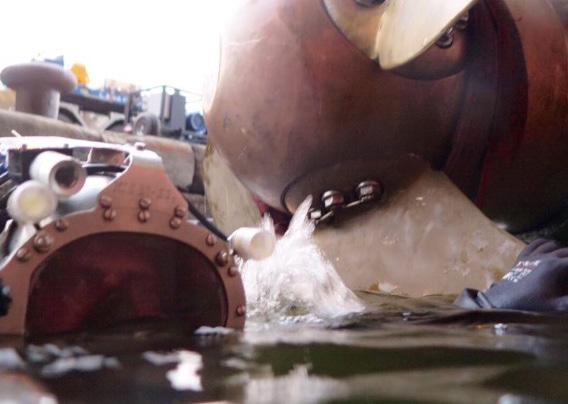
Norway’s Miko Marine has been quick to secure the services of John Gunnar Refsnes following his retirement as Commander SG from the Royal Norwegian Navy. He recently completed 42-years of active naval service which culminated in his last 12-years as the head of Norway’s Naval Engineering and Safety Centre.
After a career which found him in senior positions on-board a variety of naval vessels, he has joined Miko Marine as the company’s first damage control and technical executive. Miko will be deploying his considerable expertise and outreach as part of a new marketing emphasis that will focus on supplying Miko Marine’s products for navy, coastguard and government operated ships. This will be in parallel with an increased emphasis on the safety and damage control that is needed for passenger and cruise ships.
Commenting on his new appointment, John Gunnar said, “After many years working directly for and with the safety of seafarers and safe operations afloat, I am delighted to have been given the opportunity to continue on this course with Miko Marine after leaving the naval service.”
Miko Marine’s Managing Director, Cato Stoll has welcomed John Gunnar to the Miko team and believes that his rare expertise will be a powerful asset for its expansion into new markets. “We already employ highly qualified naval engineers and architects but John Gunnar’s specific expertise will enable us to introduce important new products to the naval and cruise sectors. With his input and endorsement, we will be confident that they will meet the strict demands of these markets.”
The repair of a tunnel thruster
Underwater repairs by FN Diving
Any bow and or stern thruster on the current market removed, overhauled/repaired in-house and replaced while the vessel stays operational and afloat typically within 2/3 weeks can be completed by FN Diving’s Rotterdam or Algeciras facilities. Afloat propulsion repairs are performed most conveniently during cargo operations which saves downtime and the cost of drydocking. If drydocking is not an option, bow thrusters can be repaired and exchanged afloat or underwater and completely overhauled with most spares on stock for the repair operation.
FN Diving has all necessary equipment in order to exchange any thruster unit on the market underwater while the vessel remains on schedule. With a special light weight tunnel blanking technique allowing dry operations for the diver/technicians, thruster blades and seals
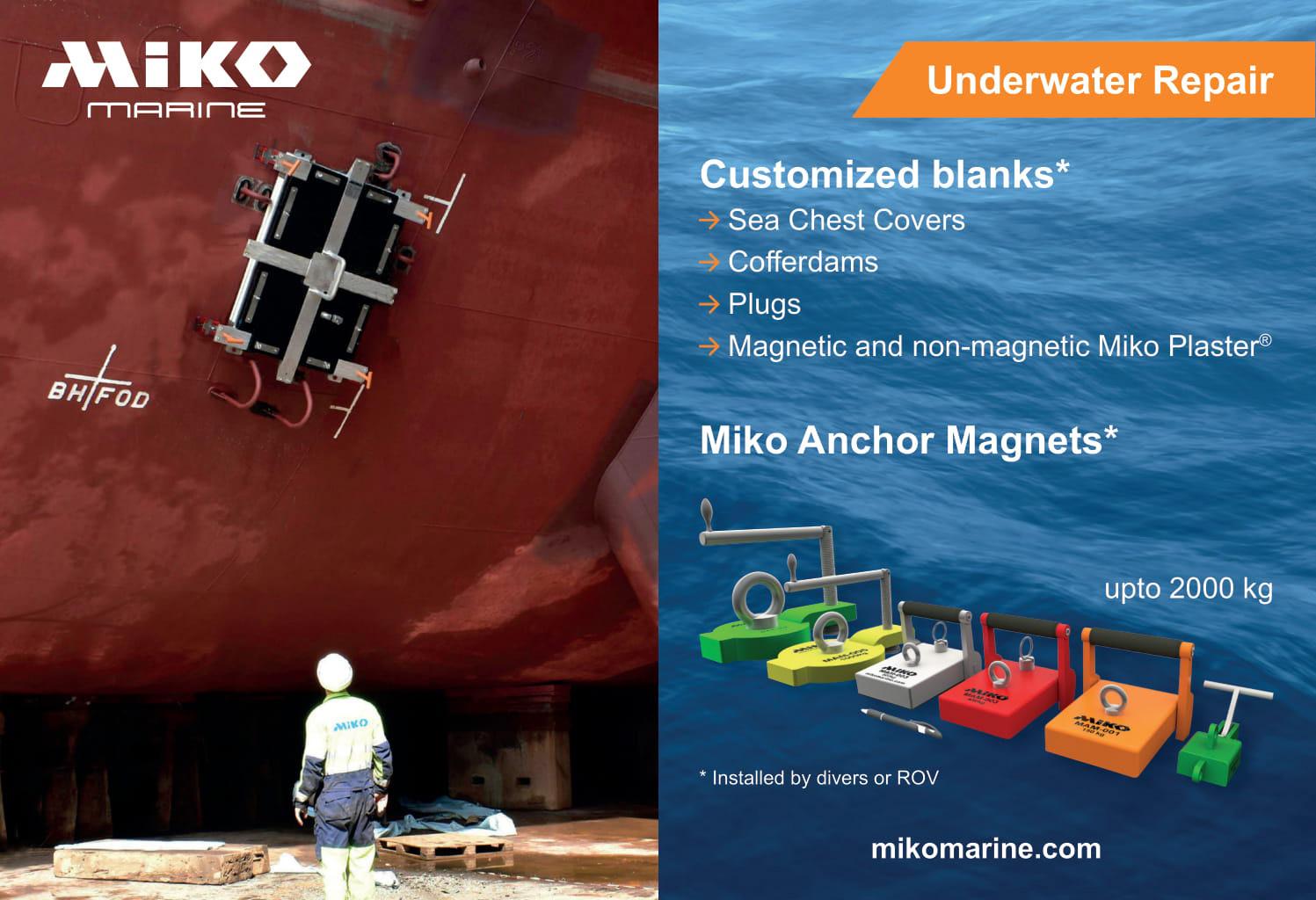
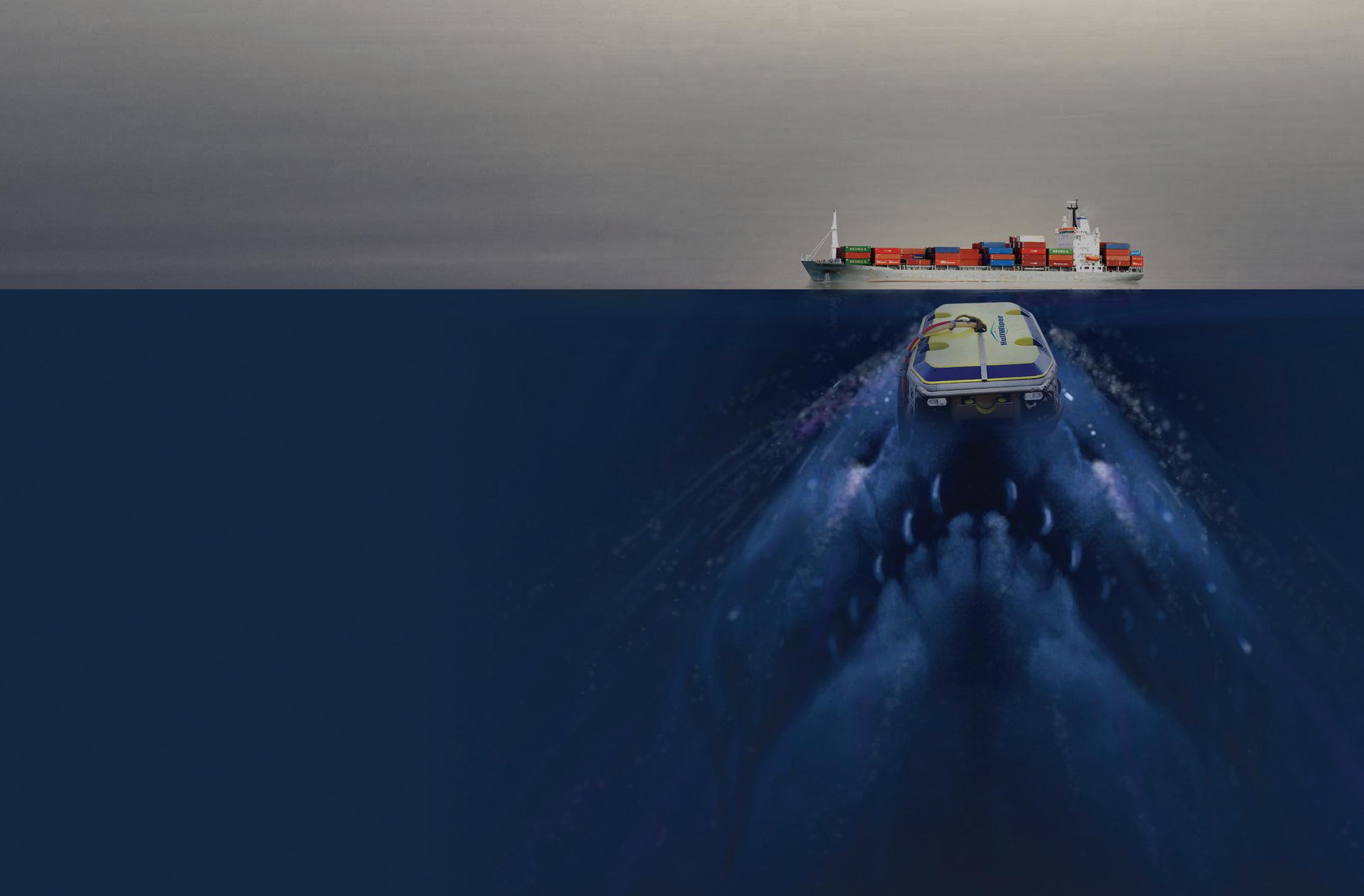
can be replaced, repair work on the gearbox or another specific part of a thruster can be performed, all while the vessel stays operational and afloat - even the complete units can be exchanged.
These bow thruster repairs are most favourably completed during normal cargo operations of the vessel. Propeller blades and seals can be replaced, repair work on the gearbox can be performed and whole units can be extracted and replaced or sent to repair in FN Diving’s workshop.
The total time for a typical tunnel thruster removal and replacement is normally under 24 hrs, with no drydocking or down time. It’s a cost effective solution that is guaranteed to get the ship back on schedule fast.
FN Diving is contactable 24/7/year round for full support and guidance regarding all underwater related operations. Perfect communication and high standards are very important in performing underwater repair and inspection operations in the shipping sector.
The diver/technicians have committed themselves to execute these jobs as cost effective and swift as possible with the highest standards and quality for operators and equipment worldwide. By doing so FN Diving’s offers Safe, Swift, Highly Cost Effective and Class approved underwater repair and inspection solutions.
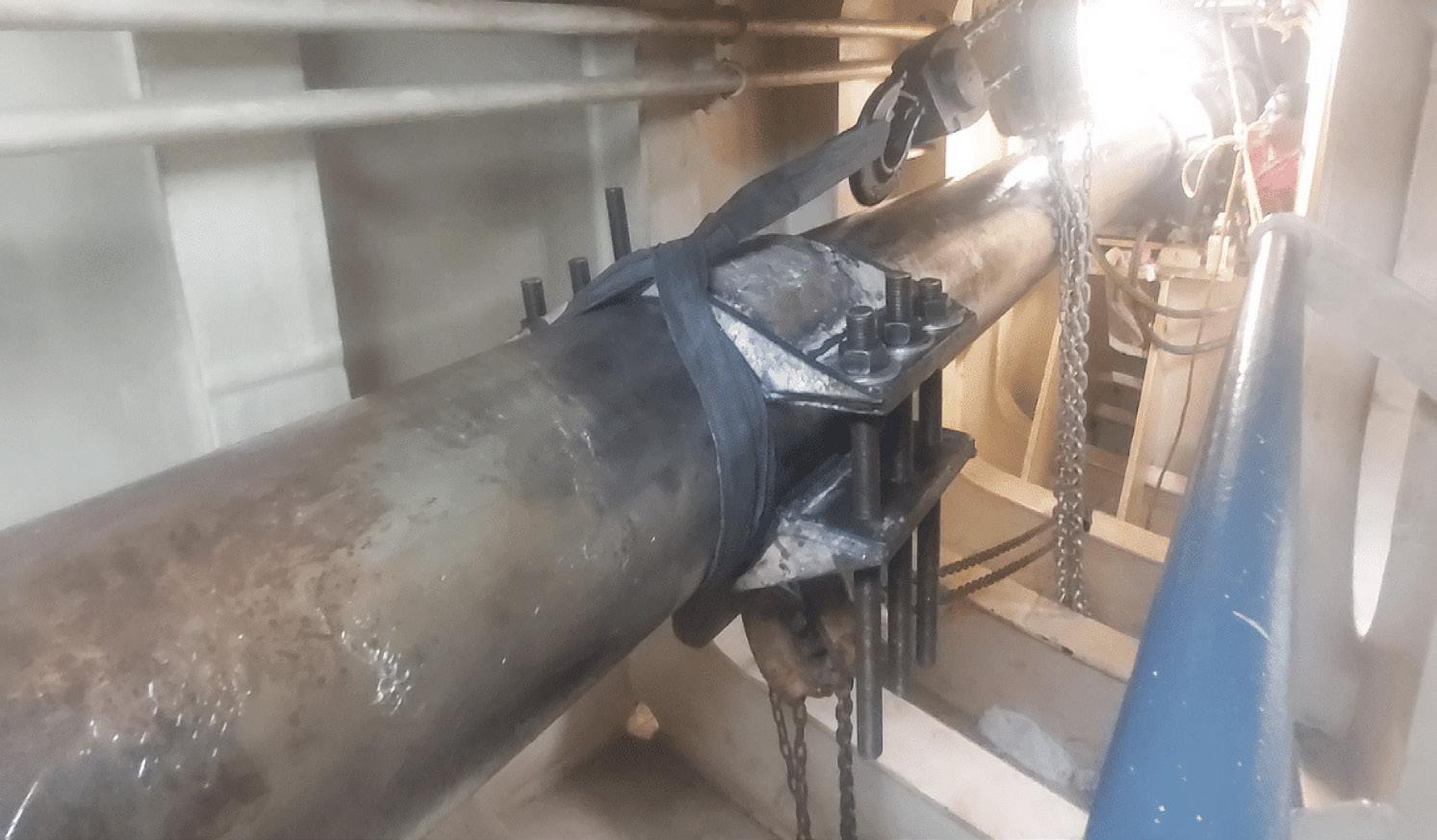
The vessel’s tailshaft after repair
Tailshaft work by SGS
A client contacted US-based Subsea Global Solutions (SGS) requiring underwater support with one of its fleet’s starboard tailshaft during the vessel’s port call in Puerto Seybaplaya, Mexico. The client indicated that the tailshaft had shifted aft approximately 200 mm when the ship’s crew was doing maintenance on the shaft coupling. It resulted in the aft water seal losing contact with the liner, causing large amounts of water ingress into the stern tube.
Local divers were called in to seal the aft seal housing with rags and underwater epoxy, temporarily stabilising the water ingress. The client ordered new OEM seals for both the forward and aft systems to allow for complete replacement. In preparation for the underwater aft seal replacement, the SGS Transhab system and SGS commercial diver/technicians were mobilised to the job site. Once onsite, the commercial dive team confirmed the tailshaft had slid aft approximately 200 mm and needed to be pulled forward and re-coupled before the tailshaft seals could be replaced.
The SGS centralised Technical Repair Department as an OEM service provider worked closely with the client to develop a unique tailshaft re-positioning procedure. This included both the underwater and internal works, followed by SGS’ standard underwater seal replacement procedure. The work was expected to be completed in five 12 hr shifts with six commercial diver/technicians and one project manager from SGS Vancouver, SGS Houston, SGS Long Beach, SGS Port Angeles, and SGS Tampa.
SGS’s internal team began by installing hold back clamps on the forward seal housing while the dive team began removing the rope guard. The tailshaft was secured internally by a specialized clamp while the propeller, tailshaft, and seal housing was prepared for repositioning. The repositioning of the tailshaft was a critical step as it required all parties to work in unison for a successful outcome. SGS’s diver/technicians supported the coupling of the shaft and the repair of the damaged controllable pitch mechanism internally. The shaft was successfully returned to its original position without any risk of water ingress to the vessel. With the tailshaft back in position, the aft and forward seal systems could be reinstalled.
After the system was pressure checked, it was thoroughly flushed and readied for testing. The controllable pitch system was tested and calibrated. The vessel then performed sea trials without any issues.
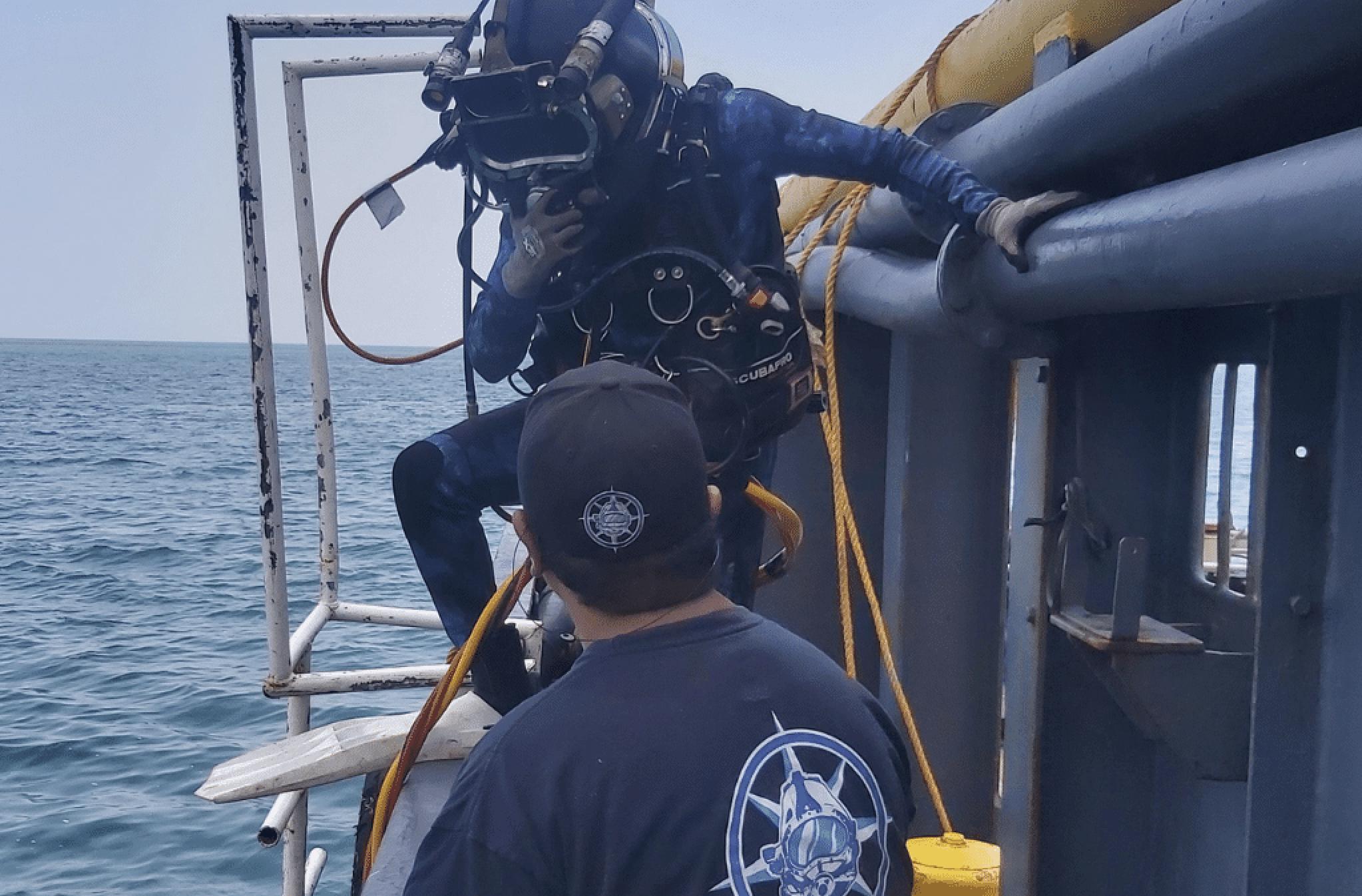
A SGS diver prepares to look at the tailshaft problem SORJ










